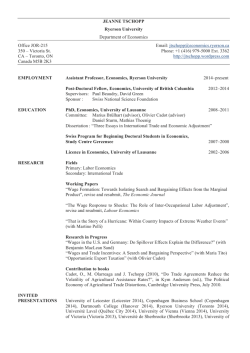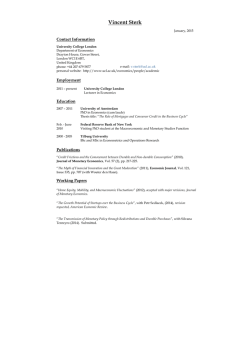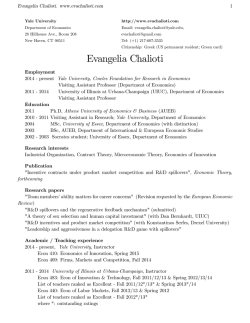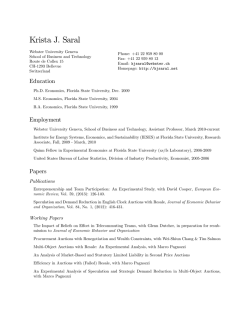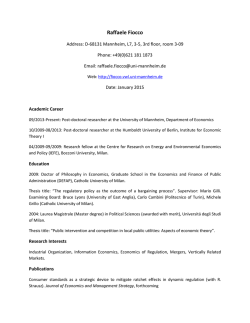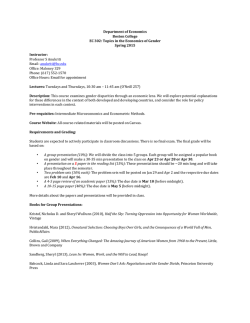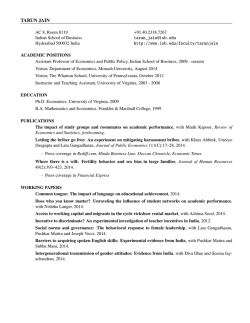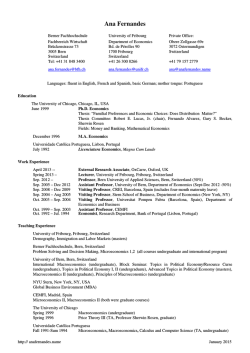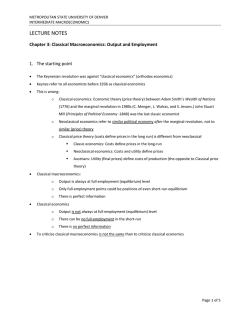
SuMMEr 2012 - Ludwig von Mises Institute
The Vol. 15 | No. 2 | 151–171 Quarterly Journal of Austrian Economics Summer 2012 The Continuing Relevance of Austrian Capital Theory Nicolai J. Foss Copenhagen Business School Norwegian School of Economics F. A. Hayek Lecture Austrian Scholars Conference Ludwig von Mises Institute Auburn, Alabama March 8, 2012 INTRODUCTION: THE CENTRALITY OF CAPITAL THEORY IN AUSTRIAN ECONOMICS I am honored and delighted that this lecture is named after F. A. Hayek. Back in the mid-1980s, Hayek’s works, particularly Dr. Nicolai Foss ([email protected]) is Professor of Organization and Strategy and Head of Department at the Department of Strategic Management and Globalization, Copenhagen Business School; and Professor of Knowledge-based Value Creation at the Department of Strategy and Management, Norwegian School of Economics and Business Administration. The author is grateful to Peter Klein for excellent comments on an earlier version of this paper, and to Joe Salerno for his support. 151 152 The Quarterly Journal of Austrian Economics 15, No. 2 (2012) his “knowledge essays”1 were my first “discoveries” of Austrian economics, prompted by the writings (on Keynes!) of Axel Leijonhufvud (1968). Hayek’s works have continued to influence me, so it is only appropriate, therefore, to pay homage to him. Specifically, I shall pay homage by addressing a favorite Hayek topic—namely that of capital theory. As we all know, much of Hayek’s early work concerned capital theory—either directly or more indirectly, as in his elaboration of Austrian business cycle theory.2 In fact, I would propose, as a conjecture in doctrinal history, that capital theory is the foundation of virtually all of his work in economics. This is obviously the case for what was intended to be the first volume of Hayek’s projected but unfinished magnum opus, namely the Pure Theory of Capital3 as well as Hayek’s many other writings on capital theory. However, I have argued myself in an old paper (1996) that capital theory played an important role in prompting Hayek’s thinking about the challenge to economic theory represented by dispersed knowledge. Roughly, the argument in that paper is that the knowledge-based challenges of intertemporal coordination of a structure of heterogeneous capital—which, as Roger Garrison has continuously reminded us,4 is the essence of Austrian business cycle theory—led Hayek to think about the role of knowledge in economic affairs.5 There is obviously a link from the early knowledge essays to his later work on political philosophy and cultural evolution,6 but it all arguably begins with capital theory. Capital theory relates to other key parts of Austrian economics. There is thus an obvious relation between heterogeneous capital and the Misesian calculation problem. Mises was—for all we know—not led to the discovery of this problem by noting the presence of heterogeneous capital in the economy per se. In fact, even if capital were homogenous, there would still be calculation 1 Hayek (1937, 1945). 2 Hayek (1931). 3 Hayek (1941). 4 See, e.g., Garrison (1985, 2001). 5 Hayek (1937, 1945). 6 See, e.g., Hayek (1973). Nicolai J. Foss: The Continuing Relevance of Austrian Capital Theory 153 problems left (how much homogenous capital to devote to production now versus later), although considerably more trivial ones than if capital is heterogeneous. And yet, to Mises, the entrepreneur and heterogeneous capital goods are complementary phenomena. As he says, “the various complementary factors of production cannot come together spontaneously. They need to be combined by the purposive efforts of men aiming at certain ends and motivated by the urge to improve their state of satisfaction.”7 Lachmann echoes this, stating that “… the entrepreneur’s function… is to specify and make decisions on the concrete form the capital resources shall have. He specifies and modifies the layout of his plant.… As long as we disregard the heterogeneity of capital, the true function of the entrepreneur must also remain hidden.”8 These examples may suffice to indicate that capital theory is a fundamental—in the sense of “foundational” and “indispensable”— part of the Austrian economics, on par with subjectivism, dispersed knowledge, and entrepreneurial appraisement, and that it is, in fact, intricately woven together with these themes. Thus, the implications of capital heterogeneity go much beyond the Austrian theory of the business cycle. My sense is that Austrians certainly know that they stand apart on the issue of capital theory. Indeed, insisting that there is such a thing as “capital theory,” which may go beyond corporate finance and the theory of investment behavior, is a bit of an oddity in contemporary economics, as Garrison (1985) has noted. However, surprisingly Austrian capital theory is also a bit of an oddity in contemporary Austrian economics. To loosely illustrate, out of the 197 articles published in the Review of Austrian Economics from 2002 to 2011 (both years included), only 11 dealt directly with capital theory. The Quarterly Journal of Austrian Economics is doing only slightly better, with 189 articles in the same period, of which 15 dealt directly with capital theory. One may fear that this reflects a belief, even among Austrians, that Austrian capital theory “lost” the historical debate; that the 7 Mises (1998 [1949]), p. 249. 8 Lachmann (1978 [1956]), p. 16. 154 The Quarterly Journal of Austrian Economics 15, No. 2 (2012) Cambridge capital controversies proved that it’s all a big mess; that Sraffa and Knight proved that Austrian capital theory was full of internal contradictions, etc. Whatever that may be, I want in this talk to argue that Austrian capital theory should make something of a comeback as a quite central item on the Austrian agenda. In arguing this I am also wearing my management scholar’s hat: It should make a comeback as essentially a part of the theory of production—that is the theory of the economic process of converting inputs into outputs—rather than part of the theory of distribution or the theory of interest. As a part of the theory of production, the Austrian theory of capital stresses the heterogeneous nature of capital assets, the subjective nature of capital as part of the entrepreneur’s plans, and the timedimension of production. Thus understood, the Austrian theory of capital has opportunities for theoretical development that we have not yet fully explored. I shall examine such opportunities in the context of business firms, drawing on work with Peter Klein,9 among others.10 And I shall argue that this in turn provides an important underpinning for our understanding of the sources of economic growth. Hence, my title: Austrian ideas on heterogeneity represent an important challenge to homogenizing assumptions in management and economics. However, these ideas not only challenge, but can also constructively further existing thinking on firms and the growth process, potentially establishing Austrian economics as a highly relevant voice in contemporary discourse on these phenomena. AUSTRIAN CAPITAL THEORY AND SHMOO CAPITAL In his treatise on ACT, Capital Theory in Disequilibrium, Peter Lewin notes that “Austrian capital theory has become synonymous in the literature with Böhm-Bawerkian capital theory.”11 Capital theory is often associated with questions, such as: “Is capital a fund? What is the nature of the earning of capital? What determines 9 See, e.g., Foss and Klein (2012). 10 See, e.g., Agarwal et al. (2009), Bjørnskov and Foss (2013). 11 Lewin (1999), p. 71. Nicolai J. Foss: The Continuing Relevance of Austrian Capital Theory 155 these earnings?” and so on. One of the latest restatements and refinements of ACT, namely Rothbard’s in Man, Economy, and State, deals with these questions as well. Such questions are conceptual, distributional, and are often couched in a macro language. At least Böhm-Bawerk of Capital and Interest (1883) and Hayek of Prices and Production (1931) often give impressions of a strong leaning to the macro side. Of course, Böhm-Bawerk’s concentric circles and Hayek’s triangles imply capital heterogeneity of the capital goods (at least between stages of production; little is said of within-stages heterogeneity). However, notions of the “average period of production” (Böhm-Bawerk) or the “total value of flow capital” (Hayek) are macro notions. These are pretty much the notions that are still associated in the mind of mainstream economists (i.e., those few who have heard of ACT!) with ACT.12 There is a danger that such macro concepts direct attention away from something very basic and very important: The fundamental heterogeneity of capital. It seems to me that this is a theme that became increasingly important in Austrian thinking on capital from about the mid-thirties. I conjecture that the Austrian business cycle theory played a role here: In Böhm-Bawerk’s stationary state, the specificities and complementarities between capital goods are easily missed, because all productive operations proceed smoothly (as they must in a stationary state). The down-turn of the business cycle, on the other hand, is very much about capital goods that simply cannot be profitably deployed in other uses for which they are not fit. “Work on the new Cunarders will be suspended,” as Dennis Robertson (1934, p. 653) put it in his variation of ABCT. Heterogeneity is brought starkly into relief by the downturn of the cycle. Not surprisingly, we therefore seem witness, from about the mid-1930s, an increasing interest among Austrians in the heterogeneity property of capital. Richard von Strigl’s Kapital und Produktion (1934) is a good example. So are Lachmann’s Capital and Its Structure (1956), and Kirzner’s neglected An Essay on Capital (1966). Peter Lewin has done important contemporary work in this vein (e.g., 12 E.g., Mark Blaug’s Economic Theory in Retrospect (1985), ch. 12. 156 The Quarterly Journal of Austrian Economics 15, No. 2 (2012) Capital in Disequilibrium, 1999). The key notion here is the fundamentally Mengerian one that capital goods are “essentially forwardlooking components of multi-period plans.”13 As Mises argued, this conceptualization in itself invalidates aggregation of capital goods: ”the totality of the produced factors of production is merely an enumeration of physical quantities of thousands and thousands of various goods. Such an inventory is of no use to acting.”14 This emphasis seems to me to move the theory of capital somewhat away from its traditional distributional concerns and concerns with interest theory, and move it more towards the theory of production. But, it is a special kind of theory of production. ACT has often been compared to classical economics. Hicks (1973) famously made the argument that the Austrians and the classicists shared the same emphasis on capital as a fund (in the process lumping Böhm-Bawerk and Hayek together with Clark and Knight!15 Now, the classical theory of capital is a part of the theory of distribution. The classical theory of production, however, is a theory of the progressive division of labor. The Austrian emphasis on heterogeneous capital aligns closely with the latter aspect of classical economics, as Allyn Young (1928) suggested. Both involve time and heterogeneity and, therefore, the need for coordination. Both the classical theory and Austrian theory of production are—therefore—sharply opposed to the way production is portrayed in modern economics, namely the “production function view.” Here is how Axel Leijonhufvud (1986, pp. 203–204, 209) characterized this view: the “neoclassical constant-returns production function,” he says, does not describe production as a process, i.e., as an ordered sequence of operations. It is more like a recipe for bouillabaisse where all the ingredients are dumped in a pot, (K, L), heated up, f(•), and the output, X, is ready. This abstraction from the sequencing of tasks… is largely responsible for the well-known fact that neoclassical production theory gives us no clue to how production is actually organized… 13 Kirzner (1976), p. 135; see also Garrison (1990). 14 Mises (1998 [1949]), p. 263. 15 See Kirzner’s (1976) critical discussion of this. Nicolai J. Foss: The Continuing Relevance of Austrian Capital Theory 157 Smith’s division of labor—the core of his theory of production—slips through modern production theory as a ghostly technological change coefficient or as an equally ill-understood economies-of-scale property of the function. What is the view of capital in the neoclassical production function view? In principle, as a purely mathematical approach, this view may seem capable of handling both heterogeneity and time. In actuality, it doesn’t handle either. This is best seen in modern mathematical macroeconomic models. Of course, mainstream macroeconomic models, given their focus on economy-wide phenomena (e.g., gross domestic or national product, employment, growth rates, etc.) tend to focus on aggregates, that is, industries, sectors, and entire economies. Aggregation, in turn, per definition leads to some kind of homogenization—as a minimum that there is some shared unit that the relevant items can be measured in terms of. Often, however, the assumption is made that everything included in the aggregate is homogenous. Thus, “labor” means homogeneous labor inputs; “capital” has the same interpretation. Paul Samuelson adopted the imagery of “shmoo” from the comic Lil’ Abner—shmoos are identical creatures shaped like bowling pins with legs—to capture this kind of homogeneity. This type of reasoning originated with David Ricardo (1817)16 who found it a useful simplification. And it can be. But sometimes—perhaps usually—economists’ assumption of homogeneity sacrifices explanatory scope on the altar of the “tractability” beloved by formalist mainstream economists. In the following, I offer a few examples of how taking heterogeneity seriously matters. I will move from macroeconomics and macro policy down to the level of firms and then up again to the level of growth. CAPITAL HETEROGENEITY AND THE CURRENT MACROECONOMICS ORGY17 The Austrian perspective on heterogeneity has mostly been lost in contemporary macroeconomic discussions. As Kenneth 16 Lachmann (1969). 17 This section borrows from Agarwal, Barney, Foss and Klein (2009). 158 The Quarterly Journal of Austrian Economics 15, No. 2 (2012) Boulding, reviewing Paul Samuelson’s Foundations of Economic Analysis, perceptively wrote in 1948: [I]t is a question of acute importance for economics as to why the macroeconomics predictions of the mathematical economists have been on the whole less successful than the hunches of the mathematically unwashed. The answer seems to be that when we write, for instance, “let i, Y, and I stand, respectively, for the interest rate, income, and investment,” we stand committed to the assumption that the internal structures of these aggregates or averages are not important for the problem in hand. In fact, of course, they may be very important, and no amount of subsequent mathematical analysis of the variables can overcome the fatal defect of their heterogeneity. Most of the discussion surrounding the stimulus packages in US and Europe has occurred at a very high level of aggregation. Despite the highly publicized failures of particular financial institutions, such as AIG, Lehman Brothers, Freddie Mac, and Fannie Mae, government officials spoke in terms of “the banking system,” “the financial system,” and the economy as a whole. Treasury Secretary Henry Paulson told Congress in September 2008 that radical steps were needed “to avoid a continuing series of financial institution failures and frozen credit markets that threaten American families’ financial well-being, the viability of businesses both small and large, and the very health of our economy.”18 The discussion of “frozen credit markets” focused on high-level indicators, with the focus on total lending, not the composition of lending among individuals, firms, and industries. The Federal Reserve System’s actions, noted Chairman Ben Bernanke, were needed to “increase liquidity and stabilize markets.”19 However, a decline in average home prices, reductions in total lending, and volatility in asset price indexes does not reveal much about the prices of particular homes, the cost of capital for specific borrowers, and the prices of individual assets. In analyzing the credit crisis, the critical question is which loans aren’t being made, to whom, and why? Indeed, it is impossible to understand the origins of the credit crisis without looking at the lending practices 18 Paulson (2008). 19 Bernanke (2008). Nicolai J. Foss: The Continuing Relevance of Austrian Capital Theory 159 of government-sponsored enterprises like Freddie Mac and Fannie Mae and policies that encouraged lenders to lower underwriting standards, on the assumption that all borrowers were “really” equally credit-worthy.20 Assumptions about homogeneity—during a period of rapid central-bank credit expansion—is at the root of the financial crisis. In short, the critical issues here are the composition of lending, not the amount. Total lending, total liquidity, average equity prices, and the like obscure the key questions about how resources are being allocated across sectors, firms, and individuals, whether bad investments are being liquidated, and so on. Such aggregate notions homogenize—and in doing so, suppress critical information about relative prices. The main function of capital markets, after all, is not to moderate the total amount of financial capital, but to allocate capital across activities. More generally, the US stimulus package, and similar proposals around the world, are characterized by Keynesian-style reliance on macroeconomic aggregates. According to the common wisdom, the bank crisis led to a collapse of effective aggregate demand, and only massive increases in government expenditure (and government debt) can kick-start the economy. However, in a world of heterogeneous capital resources, spending on some assets but not others alters the pattern of resource allocation, and, in a path-dependent process, the overall performance of the economy in the future. In such a world, capital assets just cannot be shifted costlessly from one activity to another, particularly in a modern economy in which many of those resources are embodied in industry-specific, firmspecific, and worker-specific capabilities. CAPITAL HETEROGENEITY AND THE GROWTH PROCESS Critique of conventional macroeconomics and macro policy is one of the uses of the Austrian emphasis on heterogeneity.21 That is a very worthwhile use. There are, however, also implications for the building of theory of the Austrian insistence on capital 20 Liebowitz (2009). 21 Lachmann (1969). 160 The Quarterly Journal of Austrian Economics 15, No. 2 (2012) heterogeneity. Specifically, there are implications of the very point that capital assets just cannot be shifted costlessly from one activity to another. I argued earlier that we may think of the ACT as a theory of production. This implies that we should look to the firm level. Indeed, the idea that resources, firms, and industries are different from each other, that capital and labor are specialized for particular projects and activities, that people (human capital), etc. are distinct, is ubiquitous in the theory and practice of management, particularly strategic management: Austrian ideas on capital find a close parallel in management thinking of firms as bundles of heterogeneous resources, assets, and/or activities. Peter Lewin has recently argued22 that Austrian capital theory may form the basis for a “capital-based theory of the firm.” Peter Klein and I have developed similar arguments in a string of papers and a book, Organizing Entrepreneurial Judgment (2012). To get an idea of the basic arguments, consider the world of Samuelsonian shmoo. In this word, individuals face few or no costs of searching for assets (e.g., the capabilities of potential take-over targets or suppliers) that may fit existing operations, no costs of ascertaining the inherent characteristics of assets, no costs of coordinating assets, and so on. Most of those very real problems of exchange and organization that economists put under the transaction cost rubric would evaporate in a world of homogenous capital assets. Per implication, the understanding of the sources of transaction costs in a market economy involves the understanding of capital heterogeneity and its implications. Conversely, it seems to me that a significant part of the problems of what Joseph Salerno (2008) calls “entrepreneurial appraisement” and indeed a significant part of the Misesian calculation problem itself involves transaction costs, as Peter Klein (1996) has argued. To some—namely, those who specialize in the economics of the firm and/or work in business schools—these ideas are inherently attractive. They matter a lot to me and to Peter Klein (2012). Many of you may, however, only be interested in such ideas to the extent that they have economy-wide implications. So, do they? In fact, 22 Lewin and Baetjer (2011). Nicolai J. Foss: The Continuing Relevance of Austrian Capital Theory 161 these firm-level ideas form an important micro-foundation for our reasoning about what happens at the economy-level. For example, Matsusaka (2001) argues that processes of mergers and divestments should be understood as experimental learning processes that must be undertaken exactly because it is not obvious ex ante what are the efficient combinations of assets. These micro-level processes are essentially entrepreneurial ones, because an important part of the entrepreneur’s role is to arrange or organize heterogeneous resources. In Lachmann’s (1956, p. 16) words, “We are living in a world of unexpected change; hence capital [resource] combinations... will be ever changing, will be dissolved and reformed. In this activity, we find the real function of the entrepreneur.” On the aggregate level, these processes make the economy tracking its (moving) production possibility frontier, improving the efficiency with which resources are utilized. For example, Foster, Haltiwanger, and Krizan (1998) estimate that competitive dynamics through reallocation of productive assets account for about 50 percent of aggregate productivity growth. Moreover, hampering the automatic restructuring of industries in developed countries has been shown to imply a penalty in terms of forgone growth.23 Hence, the constraints, incentives, opportunities, etc. faced by appraising entrepreneurs must ultimately enter as a crucial element in the understanding of economy-wide phenomena, not the least the sources of economic growth. Much of the understanding of the growth process in economics has essentially been based on models of accumulating Samuelsonian shmoo along equilibrium growth paths. Some applications of Austrian capital theory do allow for heterogeneity, but otherwise portray growth as a smooth process of accumulation of physical capital along an equilibrium growth path. Hicks (1967) interpreted the Austrian cycle theory as essentially a theory of how such an equilibrium growth path can be disturbed by government intervention. (According to Hicks, the essence of the “Hayek Story” was that noone really understood that Hayek was fundamentally talking about growth). He himself built a formal semi-Austrian model of 23 Audretsch, Carree, van Stel, and Roy (2003). 162 The Quarterly Journal of Austrian Economics 15, No. 2 (2012) equilibrium growth.24 Roger Garrison’s (2001) treatment of growth in Time and Money also seems to model growth in terms of accumulation of physical capital along an equilibrium growth path. However, there are also those who have argued that the growth process is driven by improvements in total factor productivity. The latter is an umbrella term for a host of highly diverse processes that to a large extent take place at the firm level. Thus, it has long been recognized that total factor productivity is about much more than “technology,” understood as recipe-like advances in scientific knowledge. Since the initial identification of the “unexplained” causes of growth in Solow’s (1956) work, significant attention has been devoted to RandD as a driver of growth.25 However, RandD itself does not drive total factor productivity; innovations that emerge from RandD do.26 In turn, innovations are introduced by enterprising individuals. In addition, innovations have many other sources than the RandD function, and they include process innovations and innovations of management and organization. Fundamentally, these processes are entrepreneurial ones: they amount to appraising, combining and recombining27 heterogeneous assets in the uncertain pursuit of profitable opportunities. Their aggregate results are productivity advances and improvements in resource utilization, that is, increases in total factor productivity. Although it stands to reason that the “entrepreneur is the prime mover of progress,”28 it is only very recently that growth economists have explicitly begun to model and measure the entrepreneurial function. The reason lies exactly in the dominance of the production function framework in growth economics: If production factors are assumed to be homogenous within categories and production is always at the efficient frontier, there is simply very little to do for the entrepreneur. In actuality, capital is heterogeneous, and the combination of capital assets requires technical and commercial 24 Hicks (1973). 25 See, e.g., Romer (1990); Coe and Helpman (1995). 26 Acs et al. (2009). 27 Schumpeter (1911), Rosenberg (1992). 28 Kirzner (1980). Nicolai J. Foss: The Continuing Relevance of Austrian Capital Theory 163 processes that are in a sense experimental in nature.29 The optimum combination of inputs is not a datum, and what is at any moment the optimum combination will change as a result of changes in underlying scarcities. These processes are driven by the judgment of capitalist-entrepreneurs. In sum, entrepreneurship positively contributes to TFP. The influence of institutions on growth has been a big theme in the recent economics of growth, to such an extent that some scholars30 argue that “institutions rule”: institutional quality overwhelms all other determinants of growth. Now, a key reason to expect institutional quality to affect growth positively is that it entails decreased transaction costs through reduced uncertainty of economic transactions and productivity-enhancing incentives. As North (1990, p. 6) explains, “[t]he major role of institutions in a society is to reduce uncertainty by establishing a stable (but not necessarily efficient) structure to human interaction. The overall stability of an institutional framework makes complex exchange possible across both time and space.” In turn, higher certainty implies lower transaction costs, as the costs of entering into, bargaining, monitoring and protecting contractual and ownership rights are reduced.31 This increases the expected value of projects, and hence makes them more likely to be undertaken. In the recent surge of interest in the institutional determinants of growth, it is arguable that the micro-foundations of the link between institutions and growth have been somewhat neglected. As Wennekers and Thurik (1999, p. 27) suggest, more attention should be devoted to the economic agents who link the institutions at the micro level to the economic outcome at the macro level. It remains veiled how exactly institutions and cultural factors frame the decisions of the millions of entrepreneurs and of entrepreneurial managers working with large companies. So, the issue is: How do institutions and economic policies (including Robert Higgs’ “regime uncertainty”; Higgs [1997]) 29 Hayek (1968). 30 E.g., Rodrik, Subramaniam, and Trebbi (2004). 31 Barzel (2005). 164 The Quarterly Journal of Austrian Economics 15, No. 2 (2012) drive total factor productivity? We know that increases in total factor productivity result from new processes, new modes of organization, ways of better allocating resources to preferred uses, and so on, that is, from processes involving start-ups as well as the entrepreneurship exercised by established firms. Given this, the flexibility (i.e., costliness) with which such changes can be carried out becomes highly important. In terms of production theory, this flexibility is captured by the notion of the elasticity of factor substitution,32 that is, the percentage change in factor proportions due to a change in marginal rate of technical substitution (e.g., in the extreme example of a Leontieff technology the elasticity is 0). The (aggregate) elasticity of substitution is a measure of the flexibility of the economy, for example, with respect to reacting to external shocks.33 The aggregate elasticity of substitution is endogenous.34 Of course, Austrian capital theory suggests that there may be inherent technical constraints so that what Lachmann (1956) calls “multiple specificities” obtain. But, it also suggests that relations of complementarity and substitutability between capital goods have a strongly subjective dimension, being characteristics of entrepreneurial planning.35 This means that the elasticities of substitution are to a large extent endogenous to institutional variables, such as those that are sometimes called “freedom variables.” In turn, a high elasticity of substitution implies high factor productivity, because it means that resources are more easily allocated to highly valued uses, new modes of organization and new processes are more easily implemented and so on. Underlying the positive impact on factor productivity of a high elasticity of substitution is a high degree of certainty in dealings, and therefore low transaction costs of searching for contract partners, bargaining, monitoring and enforcing contracts. Huge literatures in economic history, on intellectual property rights, and on innovation stress the importance for entrepreneurial activity of property rights being well-defined 32 Klump and De La Grandville (2000). 33 Acquilina et al. (2006), p. 204. 34 Arrow et al. (1961). 35 Mises (1949), Kirzner (1966). Nicolai J. Foss: The Continuing Relevance of Austrian Capital Theory 165 and enforced.36 Well-defined and enforced property rights reduce the transaction costs of carrying out entrepreneurial activities, specifically, there will be low costs of searching for, negotiating with and concluding bargains with owners of those inputs that enter into entrepreneurial ventures. Well-defined and enforced income rights imply that the risk of undertaking entrepreneurial activities is reduced. Similar reasoning applies to sound money. Inflation, and particularly erratic inflation, “jams” the signaling effects of relative prices, harming the process of allocating resources to their most highly valued uses, and therefore negatively impacts TFP. Moreover, erratic inflation makes it more risky to undertake long-term projects, and therefore may harm the incentives of those individuals who receive the residual income from such projects, that is, entrepreneurs. For many reasons the size of government influences total factor productivity. Most directly, if economic activities in certain industries or sectors have essentially been nationalized, the scope for entrepreneurship in those industries and sections is reduced, as nationalization often (but of course not necessarily) implies a public monopoly. In most parts of the Western industrialized world this is clearly the case of child care, health care, and care of the elderly. The effective nationalization of these industries means that the operation of the price mechanism becomes severely hampered,37 eliminating entrepreneurship and reducing the ability of the industries to effectively adapt to changing circumstances. To the extent that a large government is associated with high levels of publicly financed provision of various services (e.g., care of the elderly, education, etc.), with generous social security systems, and with high levels of taxation, the incentives to engage in entrepreneurship in order to make a living (what is often called “necessity entrepreneurship”) are reduced because a relatively high reservation wage is practically guaranteed and because entrepreneurial incomes are heavily taxed. Such schemes also reduce incentives for individual wealth formation which may be expected 36 See, e.g., North (1990), Glaeser et al. (2004), Mokyr (2006). 37 Mises (1949). 166 The Quarterly Journal of Austrian Economics 15, No. 2 (2012) to negatively influence the level of entrepreneurial activity.38 One reason has to do with entrepreneurial judgment being idiosyncratic and often hard to clearly communicate to potential investors.39 The entrepreneur may have to finance his venture himself, at least in the start-up phase. If individual wealth formation is reduced because of generous public transfer schemes, etc., this makes such financing difficult. Moreover, if entrepreneurs are only able to commit small amounts of personal capital to their entrepreneurial venture, their signal to potential outside investors concerning their commitment to the venture is correspondingly weaker. Christian Bjørnskov and I (2013) argue that economic freedom, including the rule of law, easy regulations, low taxes and limited government interference in the economy, allows entrepreneurial experimentation with combining productive factors to take place in a low transaction costs manner. Such institutions of liberty thereby increase the aggregate elasticity of substitution, which translates into increasing total factor productivity, and, hence, growth. To assess these ideas empirically, we build a unique panel dataset consisting of 25 countries from 1980 to 2005, and test the influence of entrepreneurship and institutions on total factor productivity. We find that entrepreneurship strongly and significantly impacts TFP, and that some institutions of liberty as well as classical liberal economic policies promote growth in productivity and thus growth. Apart from the data, the novelty of the argument is that it explicitly relies on Austrian capital theory. CODA To sum up, I have made a plea for the continuing relevance of Austrian capital theory. Historically, ACT has been a central research area in Austrian economics. Substantively, it remains an integral part of Austrianism. It has had, however, a reputation of being a particularly difficult part of the body of Austrian theory. Perhaps for this reason, it is arguable that it has been one of the less researched areas in the last four decades’ revival of Austrian economics. It is time 38 Henrekson (2005), p. 11. 39 Knight (1921). Nicolai J. Foss: The Continuing Relevance of Austrian Capital Theory 167 to change that. ACT has the potential to make interesting advances. I think there is a still a lot to do with respect to understanding the role of heterogeneous assets in entrepreneurial appraisal. There are many, fertile links to related thinking in management theory and other parts of economics, as I have argued. So, ACT can serve the strategic purpose for Austrians of extending their theorizing into new areas, while keeping intact the central core of Austrianism. To be sure, there is room in the Austrian tent for applied research on anarchism and pirates, telling mainstream economists how to do economics, integrating Austrian economics and complexity theory, and other trendy topics. However, the core of Austrian economics remains mundane topics like capital theory.40 REFERENCES Acs, Zoltan J., Pontus Braunerhjelm, David B. Audretsch, and Bo Carlsson. 2009. “The Knowledge Spillover Theory of Entrepreneurship.” Small Business Economics 32, no. 1: 15–30. Agarwal, Rajshree, Jay B. Barney, Nicolai J. Foss, and Peter G. Klein. 2009. “Heterogeneous Resources and the Financial Crisis: Implications of Strategic Management Theory.” Strategic Organization 7, no. 4: 467–484. Aquilina, Matteo, Ranier Klump, and Carlo Pietrobelli. 2006. “Factor Substitution, Average Firm Size, and Economic Growth.” Small Business Economics 26, no. 3: 203–214. Arrow, Kenneth, Hollis B. Chenery, Bagicha S. Minhas, and Robert M. Solow. 1961. “Capital-Labour Substitution and Economic Efficiency.” Review of Economics and Statistics 43: 225–250. Audretsch, David B., Martin A. Carree, André J. van Stel, and A. Roy Thurik. 2003. “Impeded Industrial Restructuring: The Growth Penalty.” Kyklos 55, no. 1: 81–98. Barzel, Yoram. 2005. A Theory of the State. Cambridge: Cambridge University Press. Bernanke, Benjamin S. 2008. Statement of Ben S. Bernanke, Chairman, Board of Governors of the Federal Reserve System, before the Committee 40 Klein (2008). 168 The Quarterly Journal of Austrian Economics 15, No. 2 (2012) on Banking, Housing, and Urban Affairs, United States Senate. September 23, 2008. Available at: http://banking.senate.gov/public/ index.cfm?FuseAction=Files.ViewandFileStore_id=bbba8289-b8fa46a2-a542-b65065b623a1. Bjørnskov, Christian, and Nicolai J. Foss. 2013. “How Strategic Entrepreneurship and the Institutional Context Influence Economic Growth.” Strategic Entrepreneurship Journal (forthcoming). Blaug, Mark. 1985. Economic Theory in Retrospect. Cambridge: Cambridge University Press. Boulding, Kenneth E. 1948. “Samuelson’s Foundations: The Role of Mathematics in Economics.” Journal of Political Economy 56, no. 3: 187–199. Böhm-Bawerk, Eugen von. 1883. Capital and Interest. 3 vols. South Holland, Ill.: Libertarian Press. 1956. Coe, D.T. and E. Helpman. 1995. “International RandD Spillovers.” European Economic Review 39: 859–887. Foster, Lucia, John C. Haltiwanger, and C. J. Krizan. 2002. “The Link Between Aggregate and Micro Productivity Growth: Evidence From Retail Trade.” NBER Working Paper Series (9120). Foss, Nicolai J. 1996. “More on ‘Hayek’s Transformation.’” History of Political Economy 27, no. 2: 345–364. Foss, Nicolai J., and Peter G. Klein. 2012. Organizing Entrepreneurial Judgment: A New Approach to the Firm. Cambridge: Cambridge University Press. Garrison, Roger W. 1985. “A Subjectivist Theory of a Capital-Using Economy.” In Gerald P. O’Driscoll, Jr. and Mario J. Rizzo, eds. The Economics of Time and Ignorance. Oxford and New York: Basil Blackwell Ltd., ch. 8. ——. 1990. “Austrian Capital Theory: The Early Controversies.” History of Political Economy 22 (supp.): 133–154. ——. 2001. Time and Money: The Macroeconomics of Capital Structure. London: Routledge. Glaeser, Edward L., Rafael La Porta, Florencio Lopez de Silanes, and Andrei Shleifer. 2004. “Do Institutions Cause Growth?” Journal of Economic Growth, 9, no. 3: 271–303. Nicolai J. Foss: The Continuing Relevance of Austrian Capital Theory 169 Hayek, Friedrich A. von. 1931. Prices and Production. London: Routledge and Sons. ——. 1937. “Economics and Knowledge.” In Friedrich A. von Hayek, Individualism and Economic Order. Chicago: University of Chicago Press. 1948. ——. 1941. The Pure Theory of Capital. London: Macmillan and Co. ——. 1945. “The Use of Knowledge in Society.” In Friedrich A. von Hayek, Individualism and Economic Order. Chicago: University of Chicago Press. 1948. ——. 1968. “Competition as a Discovery Procedure.” Marcellus S. Snow (trans.). Quarterly Journal of Austrian Economics 5, no. 3: 9–23. 2002. ——. 1973. Law, Legislation, and Liberty. Chicago: University of Chicago Press. Henrekson, Magnus. 2005. “Entrepreneurship: a Weak Link in the Welfare State?” Industrial and Corporate Change 14, no. 3: 437–467. Hicks, John R. 1967. “The Hayek Story.” In Critical Essays in Monetary Theory. Oxford: Oxford University Press, The Clarendon Press. pp. 203–215. ——. 1973. Capital and Time: A Neo-Austrian Theory. Oxford, Clarendon Press. Higgs, Robert. 1997. “Regime Uncertainty: Why the Great Depression Lasted So Long and Why Prosperity Resumed after the War.” The Independent Review 1, no. 4: 561–590. Kirzner, Israel M. 1966. An Essay on Capital. New York: Augustus M. Kelley. ——. 1976. “The Theory of Capital.” In E. G. Dolan, ed. The Foundations of Modern Austrian Economics. Kansas City: Sheed and Ward. ——. 1980. “The Prime Mover of Progress.” In Israel Kirzner and Arthur Seldon, eds. The Entrepreneur in Capitalism and Socialism. London: Institute of Economic Affairs. Klein, Peter G. 1996. “Economic Calculation and the Limits of Organization.” Review of Austrian Economics 9, no. 2: 51–77. ——. 2008. “Opportunity Discovery, Entrepreneurial Action, and Economic Organization.” Strategic Entrepreneurship Journal 2, no. 3: 175–190. 170 The Quarterly Journal of Austrian Economics 15, No. 2 (2012) Klump, Ranier, and Olivier de la Grandville. 2000. “Economic Growth and the Elasticity of Substitution: Two Theorems and Some Suggestions.” American Economic Review 90, no. 1: 282–291. Knight, Frank H. 1921. Risk, Uncertainty, and Profit. New York: Augustus M. Kelley. Lachmann, Ludwig M. 1956. Capital and Its Structure. Kansas City: S. Andrews and McMeel. 1978. ——. 1969. “Methodological Individualism and the Market Economy.” In Erich Streissler et al., eds. Roads to Freedom: Essays in Honour of Friedrich A. von Hayek. London: Routledge and Kegan Paul. Pp. 89–104. Leijonhufvud, Axel. 1968. On Keynesian Economics and the Economics of Keynes: A Study in Monetary Theory. New York: Oxford University Press. ——. 1986. “Capitalism and the Factory System.” In Richard N. Langlois, ed. The New Institutional Economics. Cambridge: Cambridge University Press. Lewin, Peter. 1999. Capital in Disequilibrium. London: Routledge. Lewin, Peter, and Howard Baetjer. 2011. “The Capital-Based Theory of the Firm,” Review of Austrian Economics 24, no. 4: 335–354. Liebowitz, Stan. 2009. “ARMs, Not Subprimes, Caused the Mortgage Crisis.” The Economists’ Voice 6, no. 12: 1655–1658. Matsusaka, John G. 2001. “Corporate Diversification, Value Maximization, and Organizational Capabilities.” The Journal of Business 74, no. 3: 409–431. Mises, Ludwig von. 1949. Human Action: A Treatise on Economics. Auburn, Ala.: Ludwig von Mises Institute. 1998. Mokyr, Joel. 2006. “Long-term Economic Growth and the History of Technology.” In Philippe Aghion and Steven Durlauf, eds. Handbook of economic growth, Oxford: Oxford University Press. North, Douglass N. 1990. Institutions, Institutional Change, and Economic Performance. Cambridge: Cambridge University Press. Paulson, Henry M. 2008. Testimony by Secretary Henry M. Paulson, Jr. before the Senate Banking Committee on Turmoil in U.S. Credit Markets: Recent Actions Regarding Government Sponsored Entities, Nicolai J. Foss: The Continuing Relevance of Austrian Capital Theory 171 Investment Banks and Other Financial Institutions. September 23, 2008. Available at: http://banking.senate.gov/public/index. cfm?FuseAction=Files.ViewandFileStore_id=04ba224a-4cee-463eb1d8-0cd771e85bd4. Ricardo, David. 1817. On the Principles of Political Economy and Taxation. London, John Murray. Robertson, D. H. 1934. “Industrial Fluctuation and the Natural Rate of Interest.” The Economic Journal 44, no. 176: 650–656. Rodrik, Dani, Arvind Subramanian, and Francesco Trebbi. 2004. “Institutions Rule: The Primacy of Institutions Over Geography and Integration in Economic Development.” Journal of Economic Growth 9, no. 2: 131–165. Romer, Paul M. 1990. “Endogenous Technological Change.” Journal of Political Economy 98: 71–102. Rosenberg, Nathan. 1992. “Economic Experiments.” Industrial and Corporate Change 1, no. 1: 181–203. Rothbard, Murray N. 1962. Man, Economy, and State. Princeton, N.J.: D. Van Nostrand Company. Salerno, Joseph T. 2008. “The Entrepreneur: Real and Imagined.” Quarterly Journal of Austrian Economics 11, no. 3: 188–207. Schumpeter, Joseph A. 1911. Theorie der Wirtschaftlichen Entwicklung. Leipzig: Dunker and Humblot. Solow, R. 1956. “A Contribution to the Theory of Growth.” Quarterly Journal of Economics 70, no. 1: 65–94. Strigl, Richard von. 1934. Kapital und Produktion. Vienna: Julius Springer Verlag. Wennekers, Alexander R.M., and A. Roy Thurik. 1999. “Linking Entrepreneurship and Economic Growth.” Small Business Economics 13, no. 1: 27–55. Young, Allyn A. 1928. “Increasing Returns and Economic Progress.” The Economic Journal 35, no. 152: 527–542.
© Copyright 2025
